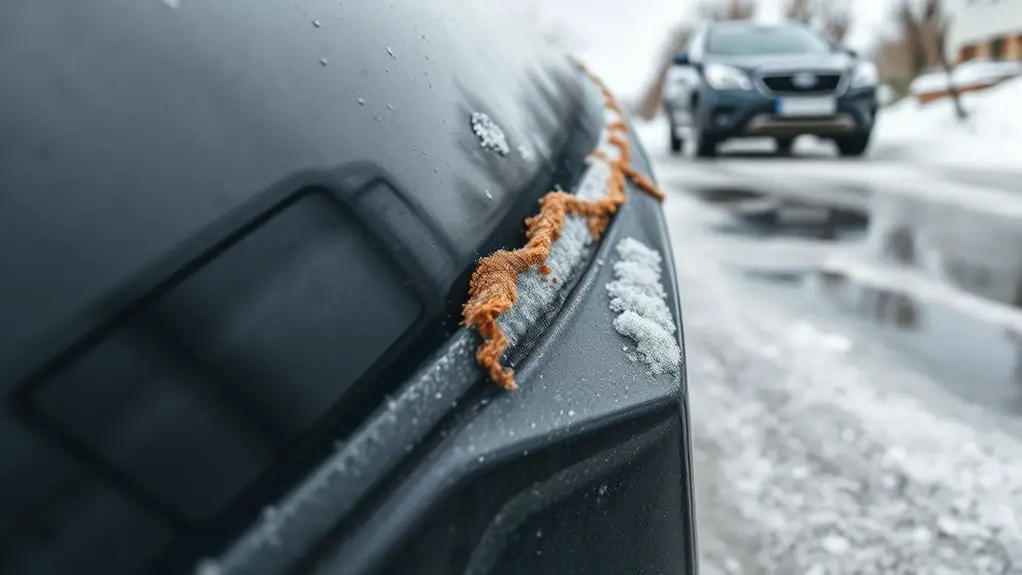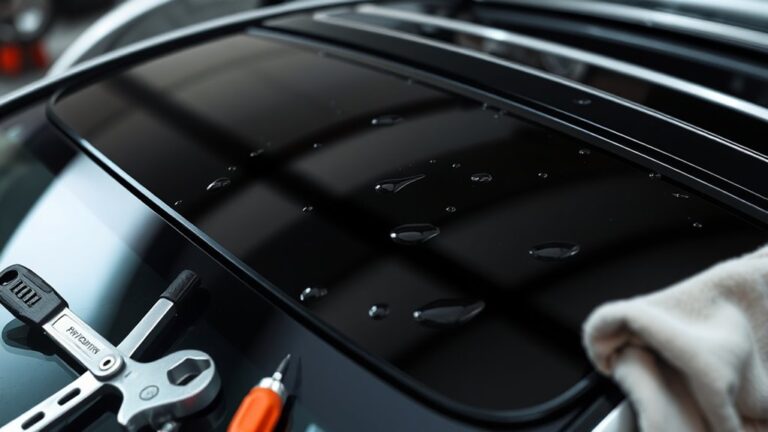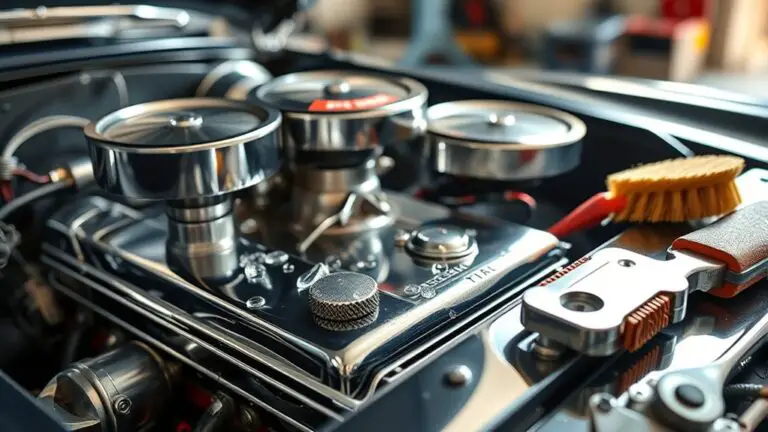How Road Salt and Climate Lead to Corroded Trim and Protection Tips
Road salt creates a conductive environment that accelerates electrochemical reactions on your trim, while freezing and thawing cycles drive microcracks open and let salt-laden moisture penetrate protective films. Humidity acts as an electrolyte, spreading corrosion into hidden crevices where debris shields metal. Cumulative moisture exposure weakens barriers, making early signs like sheen, micro-pitting, or delamination your cues. Proactive steps include drying, sealing, and using rust-inhibiting primers plus UV‑resistant sealants. If you keep going, you’ll gain reinforced protective techniques.
How Salt Accelerates Oxidation on Vehicle Trim
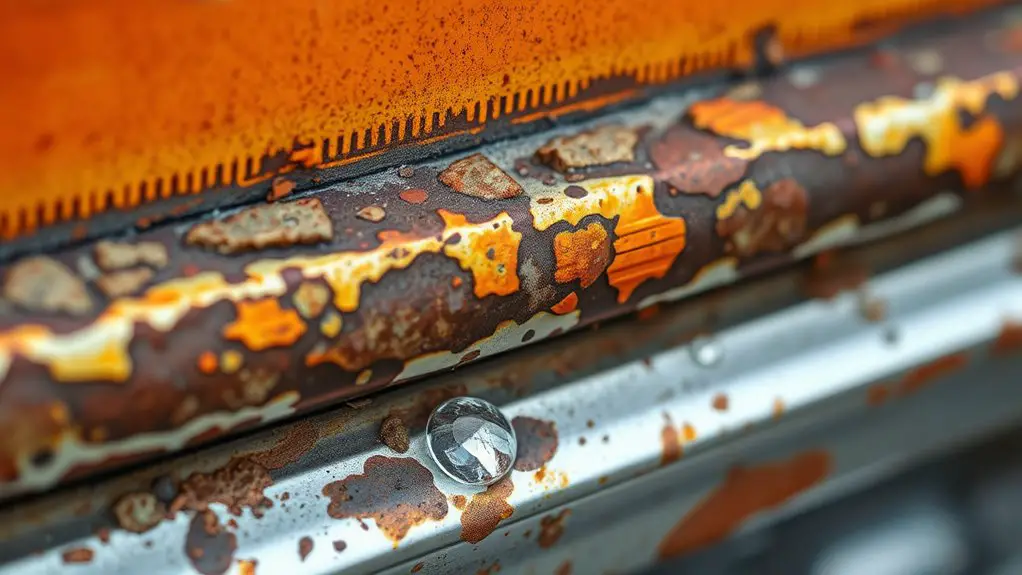
Salt accelerates oxidation on vehicle trim by creating a conductive bridge that enhances electrochemical reactions. You’ll view the oxidation process as a sequence where ions from salt interact with chrome, paint, and plastic coatings, lowering the energy barrier for electron transfer. In practical terms, this means moisture-bearing salt films establish pathways that support anodic and cathodic sites, speeding metal degradation and polymer discoloration. You’ll notice accelerated rust bloom on exposed metal edges and accelerated chalking of protective finishes, especially where protective coatings are compromised. From a vehicle maintenance perspective, the key control points are removing salt residues promptly, rinsing with clean water, and applying compatible sealants to impede ionic ingress. You’ll benefit from routine inspections of trim fasteners, seams, and underbody areas prone to salt spray. Understanding the oxidation process helps you prioritize treatments that disrupt electrochemical circuits, extending trim longevity while preserving aesthetic and functional integrity.
The Role of Freeze-Thaw Cycles in Rust Formation
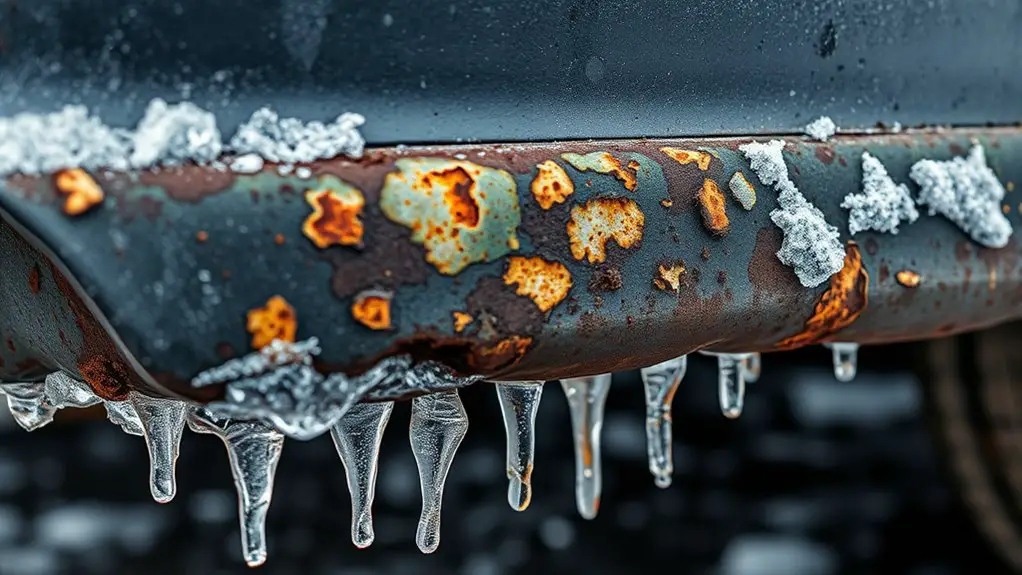
Freeze-thaw cycles exacerbate rust formation by cycling moisture through microcracks, enabling salt-laden droplets to penetrate protective films. You’ll see accelerated corrosion when periodic warming and cooling cause expansion and contraction, widening fissures that trap water and salts. This section highlights Freeze-Thaw Impact and Salt-Driven Corrosion Factors to frame mechanism and mitigation strategies.
Freeze-Thaw Impact
The cyclic alternation between freezing and thawing accelerates rust formation by repeatedly exposing metal surfaces to moisture and temperature stress, which drives microscopic cracks and microvoids that trap water and oxygen. You observe how tiny expansions from freezing push stresses into paint and coatings, creating pathways for electrolytes to migrate and accelerate corrosion at edges, seams, and fasteners. Each thaw introduces liquid water, enabling rust to propagate through compromised barriers before freezing again, locking new damage in place. Effective winter maintenance targets include sealing vulnerable joints, applying flexible coatings, and removing built-up ice to minimize dwell time of moisture. You should prioritize inspections after freeze-thaw events, monitor substrate health, and schedule timely touch-ups to limit crack growth and protect substrate integrity throughout cycles.
Salt-Driven Corrosion Factors
Even when temperatures hover above freezing, chloride-laden environments intensify rust by destabilizing protective barriers and shortening electrochemical pathways; the result is accelerated degradation at joints, seams, and exposed edges where moisture accumulates. You’ll observe repeated freeze-thaw cycles drive salt infiltration into microcracks, expanding voids as water freezes, concentrates ions, and refuels corrosion processes. Chloride ions disrupt passivation layers, lowering breakdown potentials and enabling localized pitting beneath coatings. Heat from sunlit surfaces accelerates diffusion, while wind exposure removes protective films, magnifying vulnerability. Addressing corrosion prevention requires targeted surface treatments, disciplined maintenance, and timely re-sealing to limit salt ingress. Consider environmental impact: reduced coating lifespan increases material turnover and emissions, reinforcing the need for durable formulations and preventive strategies that align with freedom-loving stewardship.
Humidity, Salt, and Hidden Nooks: Why Rust Spreads
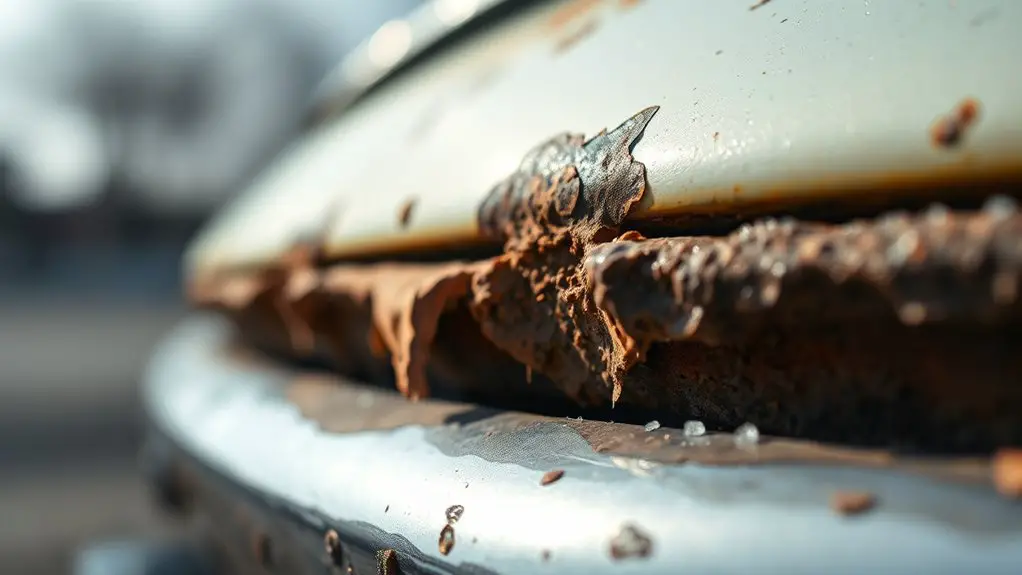
Humidity accelerates corrosion when moisture and salts are present, because water acts as an electrolyte that facilitates electrochemical reactions on metal surfaces; salt increases conductivity and lowers the potential barrier, so rust forms more quickly in damp, coastal, or humid environments. You’ll see rust propagate through hidden nooks where moisture collects, organic debris shields, and crevices trap salt residues. By understanding humidity effects, you sharpen targeted intervention: drying, sealing, and barrier coatings become essential components of corrosion prevention.
| Zone | Condition | Action |
|---|---|---|
| Hidden nook | Persistent moisture | Seal and dry, inspect seals |
| Salt exposure | Brine accumulation | Rinse, apply protective coating |
| Crevice sites | Condensation pockets | Ventilate, remove debris |
This approach is precise and technical, yet empowering: you control the environment, limit electrochemical activity, and maintain form and function through deliberate maintenance choices. The goal is clear: minimize humidity effects, fortify corrosion prevention, and preserve trim integrity for the long term.
Cumulative Effects of Small Exposures Over Time
A pattern emerges when you look beyond single exposure events: small, repeated moisture and salt encounters accumulate their impact over time, progressively elevating corrosion risk even in areas that seem minor at first glance. You observe how cumulative impacts manifest as subtle, continuous metal loss, layer by layer, driven by cycles of wetting, drying, and salt recrystallization. Each microstep pushes protective films toward saturation, reducing adhesion and accelerating galvanic interactions with adjacent alloys. Over months and seasons, tiny breaches coalesce into measurable thinning, pitting, and surface roughness that undermine trim integrity. You’ll note that temperature swings and humidity fluctuations modulate diffusion rates, so pause on detection until the damage becomes more boreneath the surface. The concept of gradual degradation emphasizes the need for timely countermeasures; delaying action allows the corrosion front to migrate, limiting restoration options and escalating maintenance costs. Plan proactive material choices, coatings, and environmental controls to mitigate cumulative impacts.
Proactive Inspections to Detect Early Corrosion
You should start with recognizing Early Corrosion Signals as your first alert to structural risk. Salt-Driven Damage Indicators guide your attention to vulnerable joints and trim connections, informing targeted inspections. Follow standardized Inspection Protocols Now to systematically verify findings and prioritize preventative actions.
Early Corrosion Signals
Early corrosion signals are best detected through targeted inspections that compare baseline material properties with current readings, enabling the early identification of degradation before visible rust or pitting appears. You’ll pursue small, repeatable checks: coating thickness, electrical resistance, and microstructure shifts, aligning results with established baseline data. Look for subtle deviations in hardness, modulus, or color changes under controlled lighting, and document environmental exposure histories. Focus on early signs such as microcracks, slight delamination, or protective layer thinning, then correlate with loading, temperature, and salt exposure to assess risk. Preventive measures emerge from this data: adjust maintenance intervals, prioritize coating repairs, and implement cathodic protection where feasible. You remain proactive, precise, and deliberate, using findings to guide durable, freedom-loving asset stewardship.
Salt-Driven Damage Indicators
Salt-driven damage indicators emerge when proactive inspections target how saline environments accelerate corrosion processes. You assess trace indicators that signal corrosion onset, focusing on salt residue patterns, stripe formation, and fastener dimples. You’ll document subtle color changes, pitting halos, and coating delamination, linking them to exposure cycles and moisture balance. This approach emphasizes measurable cues over guesswork, enabling timely corrosion prevention actions before structural impact. The table below highlights triage indicators you should flag during surveys.
| Indicator | Typical Location | Immediate Action |
|---|---|---|
| Salt residue sheen | Door jambs, hinges | Clean, re-seal, recoat |
| Micro-pitting halos | Panel edges | Flag for touch-up |
| Delamination edges | Fastener zones | Inspect substrate, repair |
Recognize patterns, record consistently, and prioritize preventive maintenance to sustain freedom from progressive decay.
Inspection Protocols Now
Proactive inspections should begin with a standardized protocol that emphasizes early detection of corrosion indicators before visible degradation. You’ll implement a structured schedule and objective criteria for signs of attack, scheduling inspections at defined intervals to balance risk with practicality. Prioritize targeted areas where salt exposure and moisture tracking are highest, maintaining repeatable paths and timestamped records. During inspections, perform visual checks to identify discoloration, flaky coatings, and substrate pitting, then log findings with quantified severity ratings. Use nondestructive techniques where feasible to confirm subsurface concerns without triggering unnecessary repairs. Calibration of inspectors against a reference catalog guarantees consistency across teams. Review results against historical trends, adjust inspection frequency as material condition evolves, and document corrective actions promptly to uphold proactive corrosion management.
Practical DIY Protection, Cleaning, and Sealant Tips
If you’re protecting metal trim, start with a clean, dry surface because dirt, oils, and oxidation impede adhesion. Begin with a targeted cleaning: a dedicated metal cleaner, followed by a rinse and dry before inspection for micro-pits. Lightly abrade glossy spots to improve bonding, then wipe with isopropyl alcohol to remove residues. For protected longevity, apply a compatible rust-inhibiting primer if corrosion is present, ensuring uniform coverage and curing per manufacturer specs. When selecting DIY sealants, favor products labeled for automotive metal trim, with high film strength and UV resistance. Apply in thin, even coats, allowing full cure between passes; multiple ultrathin layers outperform one thick layer. Post-application, inspect for pinholes, drips, or missed areas and recoat as needed. For ongoing corrosion prevention, establish a maintenance cadence: clean quarterly, reapply sealant annually, and store vehicles away from harsh, wet environments when possible. Documentation aids future touch-ups and performance tracking.
Frequently Asked Questions
Can Corrosion Affect Interior Vehicle Trim as Well as Exterior?
Yes, corrosion can affect interior materials as well as exterior. You’ll see corrosion effects—panels, fasteners, and trims reacting to moisture ingress or salt residues—manifesting as staining, delamination, or weakened structure. Interior metals and plastics may suffer galvanic or chemical attacks, while damp carpets and under-dash areas amplify the issue. Regular inspections, moisture control, and prompt remediation reduce risk; choose compatible materials, seals, and coatings designed to resist environmental exposure and maintain interior integrity.
Which Salt Types Accelerate Trim Corrosion the Most?
Magnesium chloride and calcium chloride accelerate trim corrosion most, especially in humid, winter environments you frequent. You’ll see faster degradation of plastics and coatings when these salts linger, abrade seals, and promote galvanic reactions with metals nearby. Magnesium chloride, being highly hygroscopic, intensifies moisture exposure, while calcium chloride delivers strong desiccation and ionic conductivity effects. Prioritize reducing exposure, rinsing off residues, and selecting compatible coatings to mitigate this accelerated damage.
Do Weather Patterns Influence Corrosion Risk Year-Round?
Yes, weather patterns influence corrosion risk year-round, with seasonal variations shaping exposure. You’ll see spikes during freezing cycles, thaw periods, and wet seasons, as salt-brine activity and rain drive electrolytic conduction. Climate impact also matters in humidity and temperature swings that accelerate oxide breakdown. You notice coincidences: a mild thaw followed by a cold snap can surge corrosion quickly. Plan inspections and protective measures accordingly, targeting high-risk windows, not just winter months.
How Do Coated Plastics vs. Metal Trim Compare in Rust Risk?
Coated plastics resist rust far better than metal trims. You’ll find coated plastics don’t form ferrous corrosion layers, so salt exposure, moisture, and electrochemical activity have minimal impact. Metal trims, even powder-coated ones, slowly corrode when coatings fail, especially under road salt and freeze–thaw cycles. You weigh longer life and lighter maintenance with coated plastics against potential aesthetic limits. If you prefer durability under harsh climates, coated plastics generally win, while metal trims demand vigilant coating integrity.
Are There Inexpensive Indicators of Hidden Corrosion Under Trim?
Hidden damage can exist, but inexpensive indicators are limited; you should start with a careful visual check and moisture readings. For corrosion detection, look for bubbling paint, staining, or powdery residues under trim, and use a basic magnet test where applicable. A cheap handheld moisture meter can flag elevated humidity behind panels. If you suspect hidden damage, probe edges gently and document findings, then consult a pro for confirmation and safe remediation.

